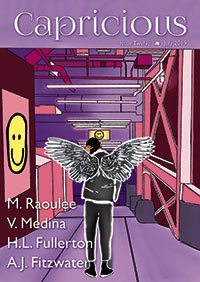Gary K. Wolfe Reviews In the Vanishers’ Palace by Aliette de Bodard
 In the Vanishers’ Palace, Aliette de Bodard (JABberwocky Literary Agency 978-1-625673-98-5, $12.99, 202pp, tp) October 2018.
In the Vanishers’ Palace, Aliette de Bodard (JABberwocky Literary Agency 978-1-625673-98-5, $12.99, 202pp, tp) October 2018.
A fair amount of Aliette de Bodard’s recent fiction seems to be about life in the ruins, most spectacularly the devastated Paris of her Dominion of the Fallen series, the result of a supernatural war decades earlier. She loves putting her characters adrift in huge, cavernous spaces. Her remarkable new novella In the Vanishers’ Palace is also set in a wasted world, only in this case the culprits are mysterious visitors called Vanishers, who arrived, enslaved and exploited the local population (which is essentially Vietnamese), and then disappeared, leaving behind a world of deadly diseases and hazardous high-tech artifacts, some of which are eventually adapted into magical totems by the surviving villagers. “The Vanishers had broken the world,” we learn. “They had taken and enslaved as they wished, leaving constructs and plagues as their legacy.” It’s an interesting echo of Philippe’s complaint in The House of Binding Thorns about the ruling houses of Paris – “they take us as needed, and discard us like so much chaff” – except that Philippe goes on to draw an explicit parallel with the French in Vietnam, “recruiting workers to cut into rubber trees, to bake bread, to lay down roads and railway tracks.” From this perspective, both that tale and this one suggest unsettling echoes of the cycles of Vietnamese history, and, from a Western perspective, there are moments in In the Vanishers’ Palace when the Vanishers sound uncomfortably like us.
If the setting is characteristic of the sort of Vancean/Wolfeian far-future in which inexplicably advanced technology gets repurposed as magic and ritual, the plot is drawn directly from one of the most malleable of literary fairy tales, “Beauty and the Beast”. Yên, the young protagonist, is a scholar who has failed her exams, and thus is regarded as expendable by her village elders. When Yên’s healer mother is unable to save a local child, the elders call upon the local dragon, whose services must be paid for with a life – and guess who that turns out to be? But the dragon Vu Côn, who can appear in the form of a human woman, really just wants Yên to tutor her unruly adolescent kids, whom she rescued years earlier from one of the Vanishers’ hatcheries. This involves bringing Yên to the Vanishers’s palace, a shifting, multidimensional structure which suggests what might have happened had Escher, Magritte, and the Wachowskis gotten hold of the Disney version. De Bodard’s intensely visual prose makes the palace virtually a character in itself. Its unpredictable permutations, along with the shapeshifting of Vu Côn and the troublesome kids – who it turns out have a substantial secret of their own – give the whole narrative a kind of odd, balletic grace.
This grace, however, overlays some grim realities. In addition to foregrounding that theme of colonialism and exploitation, de Bodard interrogates one of the more problematic aspects of the basic Beauty and the Beast tale – namely, the enormous power differential between Yên and the dragon Vu Côn. As their romance begins to develop, each grows acutely aware of this, though it takes a while for Vu Côn to realize that making decisions about other people’s lives simply because you’ve got the power to do so isn’t the sort of thing that couples counseling would let you get away with. Even before that becomes an issue, we recognize that an equally unjust and arbitrary power differential, especially involving a vindictive village elder, is what got Yên in this mess in the first place. De Bodard more or less sidesteps the gender issue implicit in the original tale by making this a same-sex relationship (although maybe there’s a species issue?), and in fact there are hardly any male characters in the novel at all. One of the village elders and both of Vu Côn’s adoptive kids are described with gender-neutral pronouns, and it isn’t until we meet a patient that the kids are experimenting on in a sort of hospital in the palace – one of a few scenes that move into horror fiction territory – that a male figure plays an important role in the plot. It hardly matters. De Bodard has taken the outline of a classic fable and turned it into a hall of mirrors as ravishing as it is disturbing.
Gary K. Wolfe is Emeritus Professor of Humanities at Roosevelt University and a reviewer for Locus magazine since 1991. His reviews have been collected in Soundings (BSFA Award 2006; Hugo nominee), Bearings (Hugo nominee 2011), and Sightings (2011), and his Evaporating Genres: Essays on Fantastic Literature (Wesleyan) received the Locus Award in 2012. Earlier books include The Known and the Unknown: The Iconography of Science Fiction (Eaton Award, 1981), Harlan Ellison: The Edge of Forever (with Ellen Weil, 2002), and David Lindsay (1982). For the Library of America, he edited American Science Fiction: Nine Classic Novels of the 1950s in 2012, with a similar set for the 1960s forthcoming. He has received the Pilgrim Award from the Science Fiction Research Association, the Distinguished Scholarship Award from the International Association for the Fantastic in the Arts, and a Special World Fantasy Award for criticism. His 24-lecture series How Great Science Fiction Works appeared from The Great Courses in 2016. He has received six Hugo nominations, two for his reviews collections and four for The Coode Street Podcast, which he has co-hosted with Jonathan Strahan for more than 300 episodes. He lives in Chicago.
This review and more like it in the December 2018 issue of Locus.
 While you are here, please take a moment to support Locus with a one-time or recurring donation. We rely on reader donations to keep the magazine and site going, and would like to keep the site paywall free, but WE NEED YOUR FINANCIAL SUPPORT to continue quality coverage of the science fiction and fantasy field.
While you are here, please take a moment to support Locus with a one-time or recurring donation. We rely on reader donations to keep the magazine and site going, and would like to keep the site paywall free, but WE NEED YOUR FINANCIAL SUPPORT to continue quality coverage of the science fiction and fantasy field.






